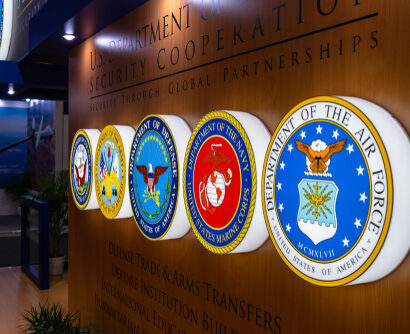Abstract: Efforts to create a common European defence date back to the Cold War, but they have so far led only to modest results. These days, with the old continent facing more complex security challenges than ever, initiatives and discussions on this topic have rekindled. However, several internal and external constraints continue to hinder this process of collectivisation of European defence.
Bottom-line-up-front: Because of their relatively small size, uncertain US security guarantees and security challenges, European countries are pushed to unite their forces to have a credible military instrument. Lack of political will, common European identity and divergence of national interests are the main obstacles.
Problem statement: How to provide a common and autonomous European defence that is accepted by Europeans and serve everyone’s interests?
So what?: While creating a European army in the near future would be impossible to achieve, a higher degree of collaboration between some like-minded countries with shared interests may be the quickest, most viable and efficient solution.

Source: www.shutterstock.com/ Vladimir Gjorgiev
Missed Opportunities and New Challenges
The first attempts to establish a common European defence force date back to least the 1950s when France, West Germany, Italy and the Benelux countries proposed the creation of the European Defence Community (EDC). This would have provided a common European army under a single military and political authority but it was eventually rejected by the French parliament in 1954.[1] Since then, discussions and initiatives on this subject have regularly resurfaced but have only produced modest results. For example, the establishment of the Common Security and Defence Policy (CSDP) in 2009 with the Treaty of Lisbon provides a valuable setting for collaboration but the requirement of unanimity to make a decision among the EU members have often prevented the development of a common European position. Furthermore, the CSDP is not competent in territorial defence and nuclear deterrence as its objectives are confined to civilian missions and military operations for the main purposes of training, crisis management, peace keeping and conflict prevention.[2] Therefore, in the status quo, national defence is a prerogative of the individual countries and of the US-led NATO.
However, due to changes in the international system, there has been another wave of enthusiasm on this issue in the last five years. The main cause is a shift in US’ security interests from Europe and the Middle-East to the Indo-Pacific. Although Russia continues to be a strong military power and the main security challenge to Europe, a fact which forces the US to remain engaged in Europe, China’s impressive economic and technological growth makes it the only potential peer competitor to the US.[3] This shift in the balance of power requires a larger allocation of US’ resources and attention to the Indo-Pacific to confront China, thus leaving Europe to take a more significant role in its own defence.
Although Russia continues to be a strong military power and the main security challenge to Europe, a fact which forces the US to remain engaged in Europe, China’s impressive economic and technological growth makes it the only potential peer competitor to the US.
This change is accentuated by the inability of Washington to fight two wars with a major power at the same time in Europe and east Asia.[4] A scenario unlikely to occur but that should not be discarded. The election of Donald Trump and the possibility of a like-minded president who is scornful of NATO in the future add further doubts regarding Washington’s traditional security role in Europe.
These factors are compounded by considerable deterioration of the security landscape around the old continent in the last ten years, namely, the return of Russia and Turkey as great military powers and increasing instability in MENA region, which does not receive the same attention by NATO as does the eastern flank.[5] This divergence of interests demonstrates that the US does not share Europe’s geopolitical priorities and challenges equally, as the former is more concerned with China. Besides, because of multiple defence shortfalls, such as Strategic Air and Sea lifting; Intelligence, Surveillance, Target Acquisition, and Reconnaissance (ISTAR); and Suppression of Enemy Air Defence (SEAD), from which Europeans are overly dependent on the US and the recent historical legacies of many countries, Europe is incapable and unwilling to tackle these security issues on its own.[6]
A New Plethora of Initiatives
As a result of these incentives, there is a growing and renewed realisation among Europeans that there is a necessity to deepen cooperation in defence in order to assume more responsibility and guarantee security. The High Representative of the Union for Foreign Affairs and Security Policy, Josep Borrell, voiced the risk for Europe to “shrink strategically” and expressed the need for “Europe to develop an appetite for power”.[7] This sentiment is felt particularly strongly in France, which would like to gain more support from the rest of Europe for its interests in Africa and the Indo-Pacific. Similarly, a common European defence is also in Germany’s interest since it is still difficult and controversial to use the military to reach foreign policy goals within a national setting. By pooling and mixing its armed forces with the rest of Europe, Berlin would reassure its neighbours and domestic critics of its purely defensive intentions toward Europe. Hence, the support by the two most powerful EU countries offers the necessary push to formulate a common defence policy.
By pooling and mixing its armed forces with the rest of Europe, Berlin would reassure its neighbours and domestic critics of its purely defensive intentions toward Europe.
The 2016 EU Global Strategy (EUSG) and the concept of European Strategic Autonomy are the key recent frameworks under which a series of initiatives were launched to guarantee the Union’s collective interests and security.[8] The Permanent Structured Cooperation (PESCO), the European Defence Fund (EDF), the Coordinated Annual Review on Defence (CARD), the Strategic Compass and the EU Rapid Deployment Capacity are the main initiatives that have been developed under these frameworks. It is important to note that these policies are not conceived as alternatives to NATO, nor do they aim to displace the US from Europe as some pundits’ fear. The unofficial division between those who would prefer a more independent Europe and those who would like to keep strong transatlantic ties is more academic than practical.[9]
PESCO, for example, is an intergovernmental defence programme with numerous projects that aim to develop common technologies and operational capabilities in training, land, maritime, air, cyber and space. In total, 46 projects were launched, from creating a European cyber academy to unmanned submersible systems. Though the programme does not aim to create a common European army, it represents an important step toward a Europeanisation of defence capabilities.[10] The EDF seeks to foster more cooperation in the research and development of joint defence technology and equipment programmes by offering financial support throughout their life cycle. More precisely, it intends to reduce costs, improve interoperability and standardisation, avoid duplication, and develop an innovative and stronger European defence industrial base.[11] CARD is another useful policy instrument that coordinates defence spending and identifies potential collaborative projects among member states. The end goal is to gradually synchronise national defence planning and capabilities. The first full CARD report was presented to defence ministers in 2020, identifying 55 potential areas of collaboration.[12]
Finally, the Strategic Compass aims to identify collective Europeans threats and develop a common strategic vision for the next 5-10 years. While the final document of the Strategic Compass will be approved only in 2022, a draft that was recently leaked to the press, outlines the necessity to adopt “more flexible decision-making arrangements” and new defence tools. For instance, the leaked document suggests the creation of EU Rapid Hybrid Response Teams to guarantee cyber deterrence and a Defence Innovation Hub.[13] Therefore, through the Strategic Compass, the EU tries to link its needs and goals in order to upgrade its strategic and operational capacity to act as a security actor.
While the final document of the Strategic Compass will be approved only in 2022, a draft that was recently leaked to the press, outlines the necessity to adopt “more flexible decision-making arrangements” and new defence tools.
With the above initiatives as a basis, the recent events in Afghanistan rekindled the debate on the necessity of a pan-European army as they highlight the EU’s dependence on the US. In particular, on this occasion, Europeans showed a lack of air-lifting capabilities and intelligence. As a result, after the initial recommendation by 14 EU countries to create a small pan-European military team, the leaked document of the Strategic Compass proposes the establishment of a 5000-strong rapid military response team called, the EU Rapid Deployment Capacity by 2025, to be deployed in case of a crisis and to be potentially expanded in the future.[14] This initiative has yet to be approved by member states, but it might be the first step toward a future European army.
Limits and Potential Scenarios of a Common European Defence
Despite the developing commitments and initiatives, several challenges hinder the process of a common European defence. This analysis identifies three main structural issues in the creation of a credible pan-European military instrument. First, the unwillingness of member states to invest financially in defence is apparent, as they are reluctant to make cuts in welfare and/or incur higher debt. PESCO and EDF are unlikely to address major capability deficits as there is an insufficient financial investment and this has been further reduced due to the pandemic-induced economic cuts.[15] Even the EU Rapid Deployment Capacity is too small to have a global relevance. These limitations cast doubt on the initiatives’ efficacy as creating common weapon systems, capabilities and institutions is meaningless if they lack the necessary volume of hard power to develop a useful geopolitical instrument. This problem is linked directly to an anti-militarist mindset and strategic culture (or lack thereof) that most Europeans developed in the aftermath of World War 2 and especially after the end of the Cold War. Since it is a cultural issue, it cannot be solved entirely by good policies and pragmatism. Only dramatic historical events might be able to change such strategic culture.
Secondly, without credible nuclear deterrence, Europeans would not be fully autonomous. France is the only EU country that possesses nuclear weapons but it is unlikely it will share them or extend their defence functions to cover other countries as there are many technical and political obstacles.[16] Not least a lack of credibility by France to use nuclear weapons to protect other European countries as this would increase the risk of a counter strike in its homeland, and the limited number of warheads compared to that of Russia.
Not least a lack of credibility by France to use nuclear weapons to protect other European countries as this would increase the risk of a counter strike in its homeland, and the limited number of warheads compared to that of Russia.
Thirdly and perhaps more importantly, the diverse national interests and identities constrain the formulation of a common security policy and, thus, military force deployment. Although the Strategic Compass will attempt to find some common ground, this cacophony of national interests and identities will be difficult to overcome in practice. This is because national interests and identities are very much embedded in historical legacy, geographical position and power capabilities. A case in point, it is doubtful that Greece would share the same threat perception of Russia as Finland. Would Greece fight a war against Russia to defend Sweden? Would the Swedes go to war in large numbers to protect Greece against Turkey? These scenarios are unlikely as countries have limited capacities, different strategic priorities, and more pointedly, going to war would imply readiness to accept heavy casualties. Under this perspective, it is unlikely that the EU Rapid Deployment Capacity will ever transform into a pan-European army.
It is also complicated to reconcile overlapping national interests, like in the case of France and Italy in north Africa during the Arab spring in 2011. While it was in Italy’s interest to have Muammar Gheddafi as head of state to control illegal immigration and keep some stability in the country, France acted almost unilaterally to overthrow the regime in spite of Italian concerns. This poses the question of precisely whose interests a European military force should serve. States are usually unwilling to compromise on such vital issues and even if they agree on a common policy, they often disagree on the means and strategy to adopt. This disagreement is demonstrated by prior failures to create common European forces, such as the EU Battlegroups, which have never been used due to a lack of unanimity among member states.[17] On the other hand, there is the risk that by focusing on these long-term initiatives, national governments avoid more pressing issues such as increasing defence budgets and adopting a more assertive foreign policy. In fact, the main problem of European security and defence is the lack of political will and ambition by member states. It is, therefore, necessary to understand the viability of these attempts and to adjust the expectations accordingly.
Disagreement is demonstrated by prior failures to create common European forces, such as the EU Battlegroups, which have never been used due to a lack of unanimity among member states.
Yet, there is also another side of the argument to take into consideration – not only political will but also popular will. According to a 2017 survey from the EU, 55% of Europeans were in favour of creating a European army, and 75% agreed on the necessity of a common security and defence policy.[18] Although the survey is a few years old and there are variations among the EU member states, like in the case of Sweden which has a lower level of support, this data shows a general trend that Europeans seem to share a more positive sentiment toward a common defence policy than expected. It is also important, since it is necessary to have a certain degree of endorsement from the electorates to launch collective military operations. Besides, national interests and identities are not carved in stone. They can change over time, and cooperation among like-minded countries is possible.
If the creation of a European army is too idealistic, other more pragmatic solutions exist. Ad-hoc coalitions of volunteers remain probably the quickest and most viable option for common European defence depending on the threat and type of missions since the countries in question have a shared interest and willingness to work together. The recent defence agreement between France and Greece and the launch of the European Maritime Awareness in the SoH (EMASOH) are clear examples of this pragmatic approach.[19] In fact, the focus should not only be on different national interests, but also on the common ones.
The Strategic Compass will play a crucial role in identifying these shared interests and goals on which Europeans can work together. In addition, an essential progression toward this direction would be the potential activation of article 44 of the Treaty of the European Union (TEU) which allows a small number of countries to pool their resources and operate together for a specific task without the unanimity voting process.[20] This possibility is also included in the leaked draft of the Strategic Compass, which will try to understand precisely how to use the article 44 to plan and conduct security mission within the EU legal framework.[21] The former German defence minister, Annegret Kramp-Karrenbauer endorsed this option, as well.[22] Eventually, though, much will depend on the external inputs that Europeans will receive in the coming years and thus on their political will. If the geopolitical situation worsens (e.g. increased military tensions with Russia and Turkey) and the US becomes more reluctant to act as a security guarantor for Europe, this will likely result in a larger defence spending and potentially more cooperation and integration among some European countries. However, if these variables remain constant, European nations may continue to be marginal security actors dependent on the US and with a gradual erosion of their geopolitical power and the capacity to protect their national interests.
Stefano Marras; Double masters’ graduate in History at the University of Bologna and International Relations at Utrecht University. Research interests include history, IR theories, geopolitics, European security and foreign policy and emerging technologies. The views contained in this article are the author’s alone.
[1] TDHJ, “The European Union: Closer or Further than Ever to Having a European Army?,” accessed October 21, 2021, https://www.thedefencehorizon.org/post/the-european-union-closer-or-further-than-ever-to-having-a-european-army.
[2] Common Security and Defence Policy | Fact Sheets on the European Union | European Parliament, accessed October 22, 2021, https://www.europarl.europa.eu/factsheets/en/sheet/159/common-security-and-defence-policy.
[3] The White House, “Interim National Security Strategic Guidance,” March 03, 2021, https://www.whitehouse.gov/briefing-room/statements-releases/2021/03/03/interim-national-security-strategic-guidance/.
[4] The Economist. “With Donald Trump gone, NATO is plotting its future,” accessed November, 2021, https://www.economist.com/europe/2021/06/12/with-donald-trump-gone-nato-is-plotting-its-future; “Summary of the 2018 National Defence Strategy of The United States of America,” https://www.jcs.mil/Portals/36/Documents/Publications/UNCLASS_2018_National_Military_Strategy_Description.pdf.
[5] Stefano Marras, “The Future Challenges to European Security,” TDHJ, October 11, 2021, https://www.thedefencehorizon.org/post/the-future-challenges-to-european-security.
[6] Hugo Meijer and Stephen G. Brooks, “Illusions of Autonomy: Why Europe Cannot Provide for Its Security If the United States Pulls Back,” International Security 45, no. 4 (20 April 2021): 7–43. https://doi.org/10.1162/isec_a_00405.
[7] Josep Borrell, “A Strategic Compass for Europe” – Project Syndicate, November 12, 2021. https://www.project-syndicate.org/commentary/eu-strategic-compass-by-josep-borrell-2021-11; Euronews, “EU must develop ‘appetite for power’ says foreign policy chief Josep Borrell,” February 17, 2020, https://www.euronews.com/2020/02/16/eu-must-develop-appetite-for-power-says-foreign-policy-chief-josep-borrell.
[8] EEAS – European External Action Service – European Commission, “A Global Strategy for the European Union’s Foreign and Security Policy,” Text, accessed October 21, 2021, https://eeas.europa.eu/topics/eu-global-strategy/17304/global-strategy-european-unions-foreign-and-security-policy_en.; EEAS – European External Action Service – European Commission, “Why European Strategic Autonomy Matters,” Text, accessed October 21, 2021, https://eeas.europa.eu/headquarters/headquarters-homepage/89865/why-european-strategic-autonomy-matters_en.
[9] In fact, these policies are meant to develop complementary capacities to strengthen the continent’s security and allow Europeans to operate autonomously in other strategic contexts when needed; Ulrike Franke, “What Are We Actually Fighting about? Germany, France, and the Spectre of European Autonomy – European Council on Foreign Relations,” ECFR (blog), November 23, 2020, https://ecfr.eu/article/what-are-we-actually-fighting-about-germany-france-and-the-spectre-of-european-autonomy/.
[10] “PESCO | Member States Driven,” accessed October 21, 2021, https://pesco.europa.eu/.
[11] “The European Defence Fund (EDF),” accessed October 21, 2021, https://ec.europa.eu/defence-industry-space/eu-defence-industry/european-defence-fund-edf_en.
[12] “Coordinated Annual Review on Defence (CARD),” accessed October 21, 2021, https://eda.europa.eu/what-we-do/EU-defence-initiatives/coordinated-annual-review-on-defence-(card).
[13] Euractiv, “LEAK: What the EU’s future military strategy could look like,” November 11, 2021, https://www.euractiv.com/section/defence-and-security/news/leak-how-the-eus-future-military-strategy-could-look-like/; “EU`s Strategic Compass for Security and Defence: A New Approach in 2021 – Finabel,” accessed October 21, 2021, http://finabel.org/eus-strategic-compass-for-security-and-defence-a-new-approach-in-2021/.
[14] Euractiv, “LEAK: What the EU’s future military strategy could look like,” November 11, 2021, https://www.euractiv.com/section/defence-and-security/news/leak-how-the-eus-future-military-strategy-could-look-like/
[15] Global Risk Insights, “Cuts in the European Defence Fund’s Budget: At What Cost?,” October 22, 2020, https://globalriskinsights.com/2020/10/cuts-in-the-european-defence-funds-budget-at-what-cost/.; POLITICO, “EU Military Projects Face Delays, Leaked Document Shows,” July 12, 2021, https://www.politico.eu/article/leaked-document-shows-delays-in-eu-military-pact/.
[16] “An Offer Postponed: Berlin’s Silence on Macron’s Deterrence Thinking,” accessed October 22, 2021, https://www.europeanleadershipnetwork.org/commentary/an-offer-postponed-berlins-silence-on-macrons-deterrence-thinking/.
[17] Yf Reykers, “EU Battlegroups: High Costs, No Benefits,” Contemporary Security Policy 38, no. 3 (September 02, 2017): 457–70, https://doi.org/10.1080/13523260.2017.1348568.
[18] “Designing Europe’s Future – June 2017 – – Eurobarometer Survey,” accessed October 21, 2021, https://europa.eu/eurobarometer/surveys/detail/2173.
[19] Atlantic Council, “Greece and France Give European Strategic Autonomy a Shot,” October 07, 2021, https://www.atlanticcouncil.org/blogs/new-atlanticist/greece-and-france-give-european-strategic-autonomy-a-shot/.; Etrangères, Ministère de l’Europe et des Affaires, “European Maritime Awareness in the SoH (EMASOH): Political Statement by the Governments of Belgium, Denmark, France, Germany, Greece, Italy, the Netherlands, and Portugal (20 Jan. 20),” France Diplomacy – Ministry for Europe and Foreign Affairs, accessed October 21, 2021, https://www.diplomatie.gouv.fr/en/french-foreign-policy/europe/news/article/european-maritime-awareness-in-the-soh-emasoh-political-statement-by-the.
[20] “Art. 44 Treaty on European Union,” accessed October 21, 2021, https://lexparency.org/eu/TEU/ART_44/.
[21] Euractiv, “LEAK: What the EU’s future military strategy could look like,” November 11, 2021, https://www.euractiv.com/section/defence-and-security/news/leak-how-the-eus-future-military-strategy-could-look-like/.
[22] Atlantic Council, “Germany’s defence minister: Only political will can protect Europe,” September 03, 2021, https://www.atlanticcouncil.org/blogs/new-atlanticist/germanys-defense-minister-only-political-will-can-protect-europe/.






